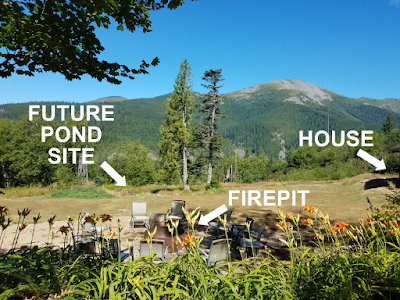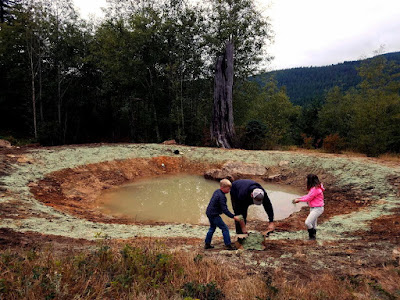4:50 pm - 47 degrees - foggy, raining...
When we were driving around looking
for property 12 years ago, we came upon this near-perfect rural off-grid
property... and we were sold!
Our property has a good amount of
acreage, gorgeous views, a nice home site, and it’s a nice distance to and from
civilization. It was perfect... except for
one small thing – it was missing a visible water feature. Yes, a river bisects our lot, but we can’t
see it from the house.
I have always wanted to live on
a lake or have a large pond or some kind of water feature within sight of the
house. It's only taken 12 years, but we finally have a
visible water feature – a pond!
A pond offers numerous benefits
for landowners: entertainment for the family, water for wildlife, aquaculture, fire
protection, erosion control, and aesthetics are but a few.
And in our case, the pond will
also hopefully offer another source of power – hydroelectric power.
For those of you who don’t know
what hydroelectric (or hydropower or hydroenergy) is – it’s a reliable source
of renewable energy that runs 24/7 for very little cost. Power is generated from the movement of water,
like waterfalls or streams, water that is stored in dams, as well as flowing in
river to create electricity. The water
flows through a turbine to help generate electricity; using the energy of
falling or flowing water to turn the blades.
The rotating blades spin a generator that converts the mechanical energy
of the spinning turbine into electrical energy that we can use to power our
home.
Even though a pond has so much
to offer, there are a lot of factors that needed to be considered first. Factors like:
- Is the land and soil actually
suited for a pond?
- Can we build the pond ourselves?
- What size of pond do we want
and what size will fit?
- How much will this project cost?
- How long will this project
take?
While Tony is the researcher, thinker,
and planner, I am one to jump in with both feet now. So when he told me that he was thinking that
he could put in a pond and wanted to know what I thought – my response was YES, the
bigger the better!
After walking around the
designated area he had picked out and visualizing his plan of attack, Tony started digging, and digging, and
digging.
The underground springs Tony tapped into, quickly started filling the hole and eventually the big hole started to look like a pond. Before the pond got too full, he added a 4” pipe that is about 2’ below the water line for our future hydropower source.
Tony also added an 18” culvert for an overflow.
After getting the edges, top
and surrounding area cleaned up, we spread grass seed covered with Turf
Mulch. The Turf Mulch is a naturally
organic product that is a ground dressing for the newly seeded area. It will help the ground retain moisture, form
a protective mat over the seed, help the grass seed germinate quicker and help
with erosion control until the grass grows in.
And we now have a 10' deep by 40'x50' trout pond! The water level is currently at
the uncapped hydro pipe, which he painted black so it would blend in a little more. Tony wanted to keep
the water at the lower level until the grass starts to grow. The trout will be coming in about a month or so. So excited for this project and how it is turning out! My husband is amazing!!













